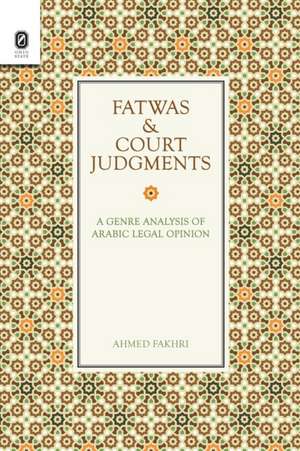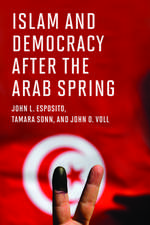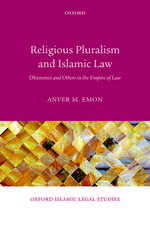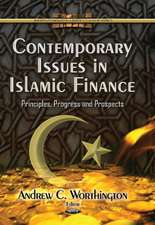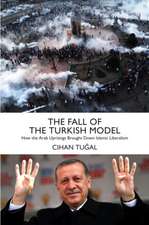Fatwas and Court Judgments: A Genre Analysis of Arabic Legal Opinion
Autor Ahmed Fakhrien Limba Engleză Paperback – 31 mai 2016
Fatwas and Court Judgments: A Genre Analysis of Arabic Legal Opinion uses a genre analysis approach to investigate how Arabic legal opinion is linguistically and rhetorically constructed in two culturally significant types of texts: secular court judgments and fatwas, the Islamic edicts based on sharii’a law. Ahmed Fakhri’s analysis shows that the court judgments exhibit several Western-inspired features, particularly the complexity of syntax and the rhetorical moves utilized to construct arguments. But the fatwas maintain conventional Arabic patterns of persuasion, such as citing religious texts, relying on affective appeal, and offering moral advice. Showing how these two radically different rhetorical traditions coexist, Fatwas and Court Judgments totally re-conceptualizes Arabic legal argumentation by highlighting its diverse sources and hybridity.
The differences between the two genres stem from elements of their socio-cultural context, such as the role relations of the participants and the characteristics of the institutions to which the genres belong. Moving beyond these contexts, Fatwas and Court Judgments reveals generic practices that have broad implications for understanding various aspects of wider Arab culture, including the tension between modern secular ideologies and traditional religious beliefs, the male-dominated access to discourse, and the prevalence of utilitarian attitudes exhibited in “fatwa shopping.”
The differences between the two genres stem from elements of their socio-cultural context, such as the role relations of the participants and the characteristics of the institutions to which the genres belong. Moving beyond these contexts, Fatwas and Court Judgments reveals generic practices that have broad implications for understanding various aspects of wider Arab culture, including the tension between modern secular ideologies and traditional religious beliefs, the male-dominated access to discourse, and the prevalence of utilitarian attitudes exhibited in “fatwa shopping.”
Preț: 249.75 lei
Nou
Puncte Express: 375
Preț estimativ în valută:
47.79€ • 49.90$ • 39.46£
47.79€ • 49.90$ • 39.46£
Carte tipărită la comandă
Livrare economică 11-17 aprilie
Preluare comenzi: 021 569.72.76
Specificații
ISBN-13: 9780814253052
ISBN-10: 0814253059
Pagini: 170
Dimensiuni: 152 x 229 x 13 mm
Greutate: 0.26 kg
Ediția:1
Editura: Ohio State University Press
Colecția Ohio State University Press
ISBN-10: 0814253059
Pagini: 170
Dimensiuni: 152 x 229 x 13 mm
Greutate: 0.26 kg
Ediția:1
Editura: Ohio State University Press
Colecția Ohio State University Press
Recenzii
“The main argument of Fatwas and Court Judgments: A Genre Analysis of Arabic Legal Opinion is that Arabic legal genres are strongly bound to their social, economic, and political context, and that therefore their linguistic and discourse features can be explained by this relationship. This is an outstanding study in the framework of Arabic scholarship, which I found inspiring and convincing.” —Manuel Fería García, Universidad de Granada
Notă biografică
Ahmed Fakhri is associate professor of linguistics at West Virginia University.
Cuprins
Chapter One: Purpose and Rationale
Purpose
Rationale
The Importance of Legal Texts in Understanding Muslim Culture
The Importance of the Contribution to Arabic Discourse
Development of Arabic Discourse Analysis: From Textual Analysis to Genre Analysis
Contribution to the Study of Arabic Legal Discourse
The Sociolinguistic Situation of Arabic
Summary
Chapter Two: Theoretical and Analytical Framework
Theoretical Framework: The Concept of Genre
Fundamental Aspects of Genre
The Swales Approach
Analytical Framework: Data and Procedure
The Institution of ’iftaa’
The Moroccan Judiciary
The Data
Analytical Procedure
Summary
Chapter Three: Rhetorical Analysis
The Rhetorical Structure of the Court Judgments
Move 1: Giving the History of the Case
Move 2: Stating the Petitioner’s Claims
Move 3: Presenting the Opinion of the Court
Move 4: Pronouncing the Decision
The Rhetorical Structure of the Fatwas
Move Analysis of the Fatwas
Variation in the Realization of Moves
Assessing the Analysis
Discussion
Degree of Structural Variation
Difference in Degree of Relevance
Summary
Chapter Four: Linguistic Properties of Court Judgments and Fatwas
Syntactic Complexity
Sentence Structure
Complex Noun Phrases
Formulaic Language
Preliminary Remarks
The Functions of Formulaic Language in Court Judgments and Fatwas
General Formulas
Formulaic Expression of Legal Concepts
Formulas with Discourse Functions
Citations
The Use of Citations in Discourse
Modes of Reference to Previous Texts in Court Judgments and Fatwas
Attribution to Authors
Summary
Chapter Five: Conclusions and Implications
The Significance of Adopting the French Model in the Court Judgments
Consequences of Borrowing on the Host Language
Morphosyntactic Adjustments
Impact of the Transfer of French Patterns on Arabic Rhetoric
Fatwas and Their Sociocultural Milieu: Mutual Influences
The Sociocultural Climate
Impact on the Rhetoric of Fatwas
Remarks on Genre and Culture
Intellectual Styles: Thought Clarity and Explicitness
Politeness and Face
Utilitarian Comportments
Gender and Access to Discourse
Suggestions for Further Research
Summary
Appendix A: Complete References of Fatwas
Appendix B: Complete References of Court Judgments
Appendix C: French Judgment
Appendix D: Key Arabic Terms
Appendix E: Excerpts in Original Arabic Script
Appendix F: Versions of a Modified Fatwa Used in the Study of the Effect of Sources on the Perceived Quality of Fatwas
Purpose
Rationale
The Importance of Legal Texts in Understanding Muslim Culture
The Importance of the Contribution to Arabic Discourse
Development of Arabic Discourse Analysis: From Textual Analysis to Genre Analysis
Contribution to the Study of Arabic Legal Discourse
The Sociolinguistic Situation of Arabic
Summary
Chapter Two: Theoretical and Analytical Framework
Theoretical Framework: The Concept of Genre
Fundamental Aspects of Genre
The Swales Approach
Analytical Framework: Data and Procedure
The Institution of ’iftaa’
The Moroccan Judiciary
The Data
Analytical Procedure
Summary
Chapter Three: Rhetorical Analysis
The Rhetorical Structure of the Court Judgments
Move 1: Giving the History of the Case
Move 2: Stating the Petitioner’s Claims
Move 3: Presenting the Opinion of the Court
Move 4: Pronouncing the Decision
The Rhetorical Structure of the Fatwas
Move Analysis of the Fatwas
Variation in the Realization of Moves
Assessing the Analysis
Discussion
Degree of Structural Variation
Difference in Degree of Relevance
Summary
Chapter Four: Linguistic Properties of Court Judgments and Fatwas
Syntactic Complexity
Sentence Structure
Complex Noun Phrases
Formulaic Language
Preliminary Remarks
The Functions of Formulaic Language in Court Judgments and Fatwas
General Formulas
Formulaic Expression of Legal Concepts
Formulas with Discourse Functions
Citations
The Use of Citations in Discourse
Modes of Reference to Previous Texts in Court Judgments and Fatwas
Attribution to Authors
Summary
Chapter Five: Conclusions and Implications
The Significance of Adopting the French Model in the Court Judgments
Consequences of Borrowing on the Host Language
Morphosyntactic Adjustments
Impact of the Transfer of French Patterns on Arabic Rhetoric
Fatwas and Their Sociocultural Milieu: Mutual Influences
The Sociocultural Climate
Impact on the Rhetoric of Fatwas
Remarks on Genre and Culture
Intellectual Styles: Thought Clarity and Explicitness
Politeness and Face
Utilitarian Comportments
Gender and Access to Discourse
Suggestions for Further Research
Summary
Appendix A: Complete References of Fatwas
Appendix B: Complete References of Court Judgments
Appendix C: French Judgment
Appendix D: Key Arabic Terms
Appendix E: Excerpts in Original Arabic Script
Appendix F: Versions of a Modified Fatwa Used in the Study of the Effect of Sources on the Perceived Quality of Fatwas
Descriere
Uses a genre analysis approach to investigate how Arabic legal opinion is linguistically and rhetorically constructed in two culturally significant types of texts.
